Volume 7:2 |
Apr - June 2010 | |
 |
Branches@ATREE | For private circulation only |
| Ashoka Trust for Research in Ecology and the Environment | ||
| Agasthya | Vembanad | Red Panda | Nesara |
2010 TN Khoshoo Awards Champion Energy Efficiency and Ecological RestorationThe 7th T.N. Khoshoo Memorial Award recognized two outstanding individuals, one in policy advocacy in the energy sector and the other in ecological restoration. The awards ceremony, held in Delhi on 11 May 2010, honoured Joss Brooks, founder of the Pitchandikulam Bioresource Centre in Puducherry, for his work on ecological restoration projects in Tamil Nadu; and Girish Sant, as part of the Prayas (Energy Group), for its policy-influencing work in the energy sector. For more information on Prayas’ and Joss Brook’s work, please visit http://www.prayaspune.org/peg/energy_home.php and http://www.pitchandikulamforest.org/cms/ 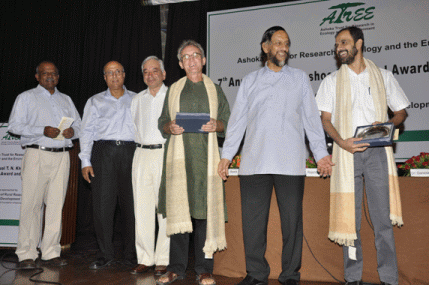
Dr. R.K. Pachauri, Director General of The Energy and Resources Institute (TERI), delivered this year’s TN Khoshoo Memorial Lecture on ‘The Scientific and Ethical Dimensions of Climate Change’. 
RESEARCHMonitoring Prey and Predator Populations in Manas National Park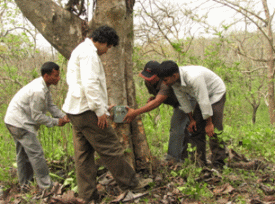
The ATREE UNESCO’s World Heritage Biodiversity Project (WHBPI) in Assam is in its 3rd year. With the objective of estimating recovery and abundance of prey and predator populations in the Manas National Park, the research team has initiated field work here. A preliminary sign survey was started in one range of the park, documenting different types of signs like pug marks, scat, scrap marks, prey kills and direct sighting of animal species. This will help in the preparation of a spatial distribution map of signs for monitoring of large carnivores and prey species using passive infra-red camera trap units. 
Integrated Ecosystem Modelling
“Rigor and complexity need not be sacrificed for simplistic needs of certainty in an ecosystem model that ought to communicate effectively to policymakers”, said Dr Gladwin Joseph to the experts gathered at the workshop to share methods and issues on integrated analysis of social, economic and ecological systems across time, space in developing countries. Indian Society for Ecological Economics (INSEE) members – Gopal Kadekodi, Deepak Malghan, Indira Devi, M Zulfiquar Ali Islam, Nandan Nawn, Narendra Nath Dalei, Rakesh Kumar Sharma, Saudamini Das, Yamini Gupt and Seema Purushothaman (organiser from ATREE), presented their work at the workshop that had other country participants from Tunisia, Bangladesh, Netherlands, Indonesia, Kenya, Brazil and Germany, also presenting their work on such models. 
Controlling Uppilu in BRT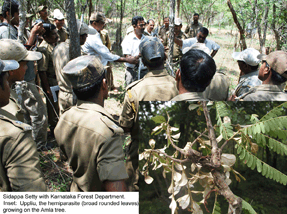
Soliga tribes in the Biligiri Rangaswamy Temple Wildlife Sanctuary (BRT WLS) earn a major portion of their income from amla, a Non-Timber Forest Produce (NTFP), of which they extract an average of 400 tonnes every year. This livelihood source is under serious threat as a result of hemiparasite infection. The hemiparasite, called Uppilu (Taxillus tomentosus) in local parlance, impacts almost 51% of the amla population resulting in low fruit production and reduction of fruit and seed weight. Plucking out uppilu offers temporary benefits; instead removal of uppilu by chopping infected branches is permanent and has additional benefits of reducing the risk of future infection and increasing productivity. 
Increasing Research Capacity through Collaborative ActivityIn recognition of a shared interest and concern for the natural world, ATREE and the Natural History Museum (NHM), London, UK, signed a Memorandum of Understanding. The MoU seeks to promote understanding and conservation of the natural world, encouraging ATREE and NHM to develop collaborative activities in various ways, including; joint research and publications, collections department, joint fieldwork, specimen loans, information access and exchange, access to institutional resources, joint organization of conferences, courses and seminars. 
ACADEMY MATTERSLaunching ‘Nesara’ - Newsletter of DBT’s Natural Resources Awareness (DNA) ClubA bilingual newsletter called 'Nesara' meaning ‘the rising sun’ that will serve as a platform for students and coordinators of DNA club to share stories, poems, art, concerns and observations related to bio-resources was launched recently by the DNA club. The first issue (Jan – Mar 2010) is available online at http://atree.org/sites/default/files/agasthya/news_ltr_mar.pdf 
Introducing Young Minds to Conservation of Bioresources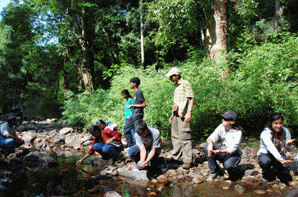
Twenty one secondary school students attended the yearly bio-resource course which was held from 26 April to 15 May at ATREE, Bangalore. The objective of the course was to introduce students to research areas and issues pertaining to the use and conservation of natural bio-resources. Eminent scientists and experts lectured on biodiversity, urban wildlife, wildlife rehabilitation, waste management, sustainable agriculture, conservation, water quality monitoring, sustainable living and forest products, followed by assignments and group projects. 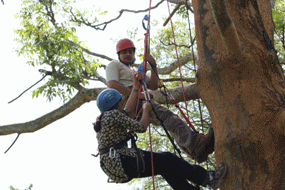
Field trips exposed students to the application of concepts, introducing them to the skills required for doing field work on bio-resources. This included visits to the Biligiri Rangaswamy Wildlife Sanctuary, Ramanagara Vulture Nesting area, Ranganthittu Bird Sanctuary, Butterfly Park in Bannerghatta National Park, and Navadarshanam - an eco ashram. Documentaries on wildlife, conservation and livelihoods introduced students to global perspectives on issues relating to the environment. Visits to ‘Natural Remedies’ and ‘Central Institute for Medicinal and Aromatic Plants’ provided opportunity to learn and get acquainted with institutional research. Tree climbing was a novel activity that allowed students to appreciate the canopies of forests. Map reading and navigation to orient them in a new landscape, sharpening observation skills by sketching birds for identification, identifying plants and insects, testing the quality of water, taking GPS points, were the other new activities introduced in this year’s course. 
Encouraging Young Scholars and Raising Awareness about Heritage Sites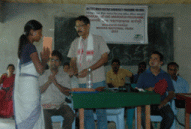
For the second year running in the World Heritage Biodiversity Programme for India (WHBPI) project in Assam, ATREE undertook a scholarship programme for young scholars from schools in the fringe villages of Manas and Kaziranga National Parks. The students are selected on the basis of means and merit and include primary and high school students. This is an outreach programme that targets teachers and parents as well as students, with the aim of raising awareness on the value of conserving the world heritage sites where they dwell. 
Nature Talkies Launched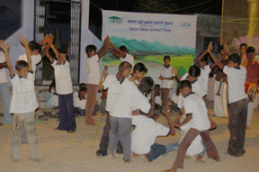
An effective way to convey the message of conservation to rural audiences is through skits and dramas woven into local concepts. On 5 June, World Environment Day, ATREE’s Community-based Conservation Center (CCC) at Singampatti launched a performance art group named Nature Talkies with 13 children from ATREE’s Green Brigade and 6 more from the nearby Mukkudal village. These youngsters were trained in Kalialattam, Kolattam and street dramas by well known folklore artists in the area, Mr. Elango, Mr. Kanagalingam and Ms. Merlin Gnana Jeeva. Staging dramas and skits revolving around protection of water resources and biodiversity, Nature Talkies performed at several villages in the presence of local leaders, educationists and environment officials. The kids not only won accolades for their talent but effectively conveyed the importance of environment conservation to rural folk. 
POLICYRedrafting the Kerala Fishery Bill 2010With the objective of combining the existing bills related to inland fisheries, the Government of Kerala has recently notified a draft Kerala Inland Fishery Bill, 2010. Fisheries experts and traditional fishermen of the inland fisheries sector are apprehensive that the Bill does not represent stakeholders. In this backdrop, ATREE’s Vembanad CERC organised a consultation workshop to create a common platform for the exchange of views between the experts, stakeholders and other NGOs at Alappuzha on 8 June 2010. After a detailed analysis of the draft bill, members at the workshop uncovered several gaps in the bill and decided to recommend redrafting the bill, adding ATREE's suggestions. The opinions were consolidated and submitted to Mr. S. Sharma, Hon. Minister for Fisheries, Kerala. 
Draft Regulatory Framework for Wetlands Conservation - Comments by ATREEThe Ministry of Environment and Forests released a draft of the regulatory framework for wetland conservation - Wetlands Conservation and Management Rules (2009) for feedback from all stakeholders. The draft framework was prepared by a multi-disciplinary expert group, and final round of comments were invited till 21 June 2010. The Wetland conservation team of ATREE did a detailed analysis of the draft regulation and submitted pertinent concerns to the Ministry. The most significant observation is that the new framework continues to propose unjustifiable state control and interventions over the country's wetlands and livelihoods of people dependent on them. 
OUTREACHWorld Environment Day Celebrations at ATREE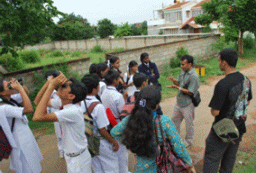
This year, ATREE, Bangalore celebrated World Environment Day with organized birding and plant and insect identification for neighbourhood schools and local residents. Eminent scientist and founder trustee of ATREE, R. Uma Shaanker, spoke about bioresources and engaged the young audience with hands-on experiments on plants and insects. The morning ended with the film by Yann Arthus-Bertrand, ‘Home: A documentary on Mother Earth’. Other activities included a vermi-composting demo (by organic farmer Ambareesh of Doddaballapur); volunteers had children create artwork using natural materials to express their thoughts about the environment. 
2010 Vembanad Fish Count Reveals Fall in Number of Species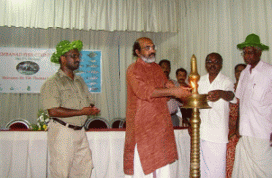
Scientists, naturalists, fishermen and students came together in the third participatory fishery resource inventory and monitoring of the Vembanad Lake on 26 and 27 May which was organized by CERC-ATREE. The count revealed a fall in population of various species. There were 52 species of fin fish as compared to 62 species found last year. However, the Kumarakom-Pathiramanal belt reported the highest species count, indicating that the area is still a biodiversity hot-spot. Citizen volunteers were shocked at the sight of several hundreds of fish trapped to death in plastic bags and diapers that lay on the lake-bed.

Participatory Resource Monitoring of Rock Bees in Nagaland
ATREE is working with honey harvesters of Naga tribes in Saramati Range in Kiphire District, Nagaland on rock bee resource monitoring and prudent methods of honey harvest through the Nagaland Beekeeping and Honey Mission (NBHM). Initially, in 2009, ATREE conducted workshops to build capacity of NBHM staff on improved methods of honey harvest and monitoring bee colonies in the wild (see Branches Vol 6.3). More recently, in March 2010, ATREE conducted pre-harvest meetings with honey harvester communities. 
CEPF-ATREE Western Ghats Programme ActivitiesThe second round of CEPF-ATREE Western Ghats Small Grants call for applications in February generated 73 applications that were then screened for eligibility, and prepared for review. The three applications for Large Grants cleared for the second stage, were sent out to internal and external reviewers for comments, and the responses conveyed to CEPF Secretariat. Project sites of current small and large grantees of the CEPF-ATREE Western Ghats Programme are available at http://maps.atree.org/cepf_sites.php. Find more programme details at: http://www.atree.org/CEPF_WGhats/ 
RECOGNITION AND HONOURS
Sharachchandra Lele, Senior Fellow and Convenor - The Centre for Environment and Development and Programme Leader - Forest and Governance, was awarded the Charles Wallace Trust for India Visiting Fellowship, Centre for South Asian Studies, Cambridge University, Lent 2011; Yusuf E Hamied Visiting Lecturer, Cambridge-India Partnership, Cambridge University, Summer 2010. 
NEWInternMs. Emma S. Karki. She will be working under the supervision of Dr. Srinivas Badiger from 3 June to 31 July 2010. 
Staff
Allwin Jesudasan, Sr. Research Associate 
Faculty
Dr. Subhrajit Saha, Fellow, Ph D in Forest Resources and Conservation from University of Florida, Gainesville, FL, USA

Visiting FellowDr. H.N. Kumar, Research Associate, National Institute of Advanced Studies, Bangalore, (November 2009 – December 2010). 
Publications
Anitha, K., S. Joseph, R.J. Chandran, E.V. Ramasamy, S. Narendra Prasad. 2010. Tree species diversity and community composition in a human-dominated tropical forest of Western Ghats biodiversity hotspot, India. Elsevier B.V. Ecological Complexity, Volume 7, Issue 2, June 2010, Pages 217-224. 
Book Chapter
Ravikanth, G., R. Vasudeva, K.N. Ganeshaiah and R. Uma Shaanker. 2010. Garcinia Forest Gene Banks: an alternative approach for the conservation of Garcinia Genetic Resources of the Western Ghats. In: Proceedings of the National Symposium on Garcinia Genetic Resources: Linking Diversity, Livelihood and Management. Vasudeva, R., B.S. Janagoudar, B.M.C. Reddy, S. Bhuwon and H.P. Singh (eds), Published by College of Forestry, Sirsi, India. 
ManualKumar, A.B., K. Krishnakumar, K.M. Abraham. 2010. River Fish Monitoring Programme: Manual of methodology. Published by Kerala State Biodiversity Board, Thiruvananthapuram, Kerala. 
Popular Press
Harini Nagendra, ‘Whither giant trees?’ Deccan Herald, 6 June, 2010. 
Talks by ATREE Staff
Sharachchandra Lele, public talk on ‘Forest Governance in a Globalizing World: Some insights from India’ at the ‘Yusuf E Hamied Visiting Lecture’, organized by Cambridge-India Partnership, University of Cambridge, Cambridge, UK, 9 June 2010. 
Workshops Organized
‘Integrated Ecosystem Modelling’, a workshop to share methods and issues on integrated analysis of social, economic and ecological systems across time, space in developing countries. Organized by ATREE, Land Use Policies and Sustainable Development in Developing Countries (LUPIS) and Indian Society for Ecological Economics (INSEE) at ATREE, Bangalore, on 23 – 24 June, 2010. 
Talks at ATREE
Dr. Jyoti Prakash Tamang, ‘Diversity of Ethnic Fermented Foods in the Himalayas’, 22 June, 2010. 
Workshop Attended
Sushmita Mandal, ‘Community Forest Rights’ to assess the status of community forest rights across the country, look at successful strategies issues of post rights claim scenarios and the nature of institutional arrangements that community institutions might embark upon to make community forest rights a right. Organized by Vrikshamitra on 23 - 25 April, Mendha Lekha, Gadchiroli district, Maharashtra. 
Poster PresentationCEPF-ATREE Western Ghats Small Grants Program presented a poster in the 'Who's Who in Conservation’ section at the Students Conference on Conservation Science held at IISc, Bangalore from 16 - 18 June, 2010. 
Grants Received
Ravikanth G. received a grant of Rs. 56.64 lakhs towards a project on ‘Biotechnological interventions for conservation and utilization of forest resources’ from the Department of Biotechnology (DBT), New Delhi. |
|
|
You are receiving this letter as a friend of ATREE, If you wish to unsubscribe, click on Unsubscribe |
